#Jazz Flutists
Text
Exploring the Avant-Garde Genius of Henry Threadgill
Introduction: Unraveling the Musical Tapestry
In the rich tapestry of avant-garde jazz, few figures loom as large or as enigmatic as Henry Threadgill. A master composer, multi-instrumentalist, and visionary bandleader, Threadgill has carved out a singular path in the music world, pushing the boundaries of genre and defying categorization. In this blog post, we embark on a journey through the…

View On WordPress
#David Murray#Diedre Murray#Henry Threadgill#Jazz Composers#Jazz Flutists#Jazz History#Jazz Saxophonists#Roscoe Mitchell
2 notes
·
View notes
Text
Bobbi Humphrey
youtube
Jazz flutist Barbara Ann "Bobbi" Humphrey was born in 1950 in Marlin, Texas. Humphrey is often called the "First Lady of Flute". During her career, she has performed with Duke Ellington and played on a Stevie Wonder album. She landed her first record deal at the age of 21, becoming the first woman to sign with Blue Note Records. In 1973, Humphrey released her first LP to enormous commercial success, and was invited to perform at the prestigious Montreux International Music Festival. In 1976, Billboard named her "Best Female Instrumentalist". In 1994, Humphrey founded her own record label, Paradise Sounds Records.
#flute#flutists#jazz#jazz musicians#women musicians#black women#black history#african-american#Youtube
6 notes
·
View notes
Text

Jerome Richardson – Midnight Oil
Midnight Oil is an album by saxophonist Jerome Richardson recorded in 1958 and released on the New Jazz label in 1959.
Jerome Richardson – tenor saxophone, flute
Jimmy Cleveland – trombone
Kenny Burrell – guitar
Hank Jones – piano
Joe Benjamin – bass
Charlie Persip – drums
3 notes
·
View notes
Audio

Herbie Mann - The Wailing Dervishes (Stereo) (1967)
Herbie Mann
from: "The Wailing Dervishes" (LP)
Jazz | Ethno Jazz | World Music
JukeHostUK
(left click = play)
(320kbps)
Personnel:
Herbie Mann: Flute
Roy Ayers: Vibraphone [Vibraharp]
Chick Ganimian: Oud
Reggie Workman: Bass
Moulay “Ali” Hafid: Goblet Drum [Dümbek]
Bruno Carr: Drums
Produced by Nesuhi Ertegun
Recorded Live:
@ The Village Theater
in New York City, New York, USA
on June 3, 1967
Released:
in March of 1968
Atlantic Records

"Herbie Mann, was an American jazz flute player and important early practitioner of world music." - Wikipedia
Herbie Mann:
https://en.wikipedia.org/wiki/Herbie_Mann
#Jazz#Herbie Mann#World Music#The Wailing Dervishes#Flute#Atlantic Records#Nesuhi Ertegun#Ethno Jazz#1960's#Flutist#Flautist
4 notes
·
View notes
Text
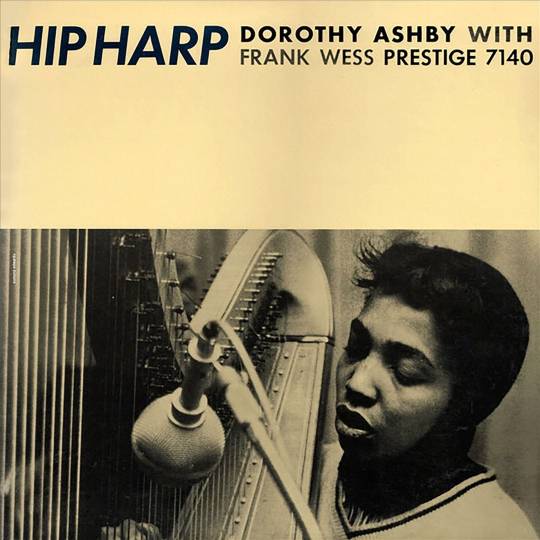
AllMusic Staff Pick:
Dorothy Ashby
Hip Harp
Released in 1958, the second album from groundbreaking jazz harpist Dorothy Ashby is a mellow, grooving affair. Along with a sturdy rhythm section and flutist Frank Wess, Ashby uses her deftly controlled harp to steer the album's seven laid-back selections. Ashby would later venture into psychedelic soul jazz, but on Hip Harp the moods are strictly cool.
- Fred Thomas
40 notes
·
View notes
Text

The flute solos played by the Pied Piper were played by Jeremy Steig, a well-known jazz flutist. He is also the son of the late William Steig, the author of the original Shrek books.
10 notes
·
View notes
Text

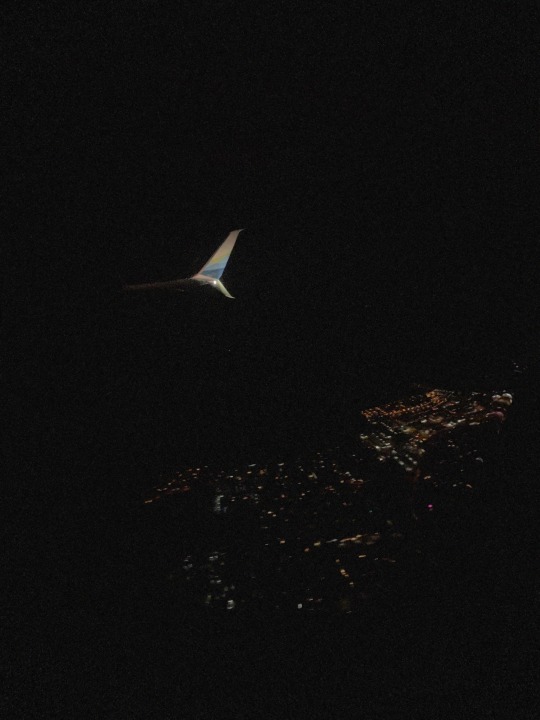

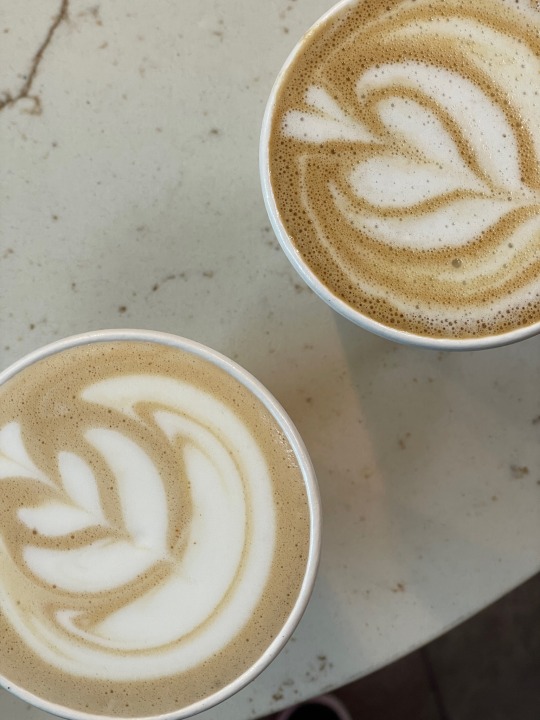
04/20/2023
hello! ive been mia lol, but it's been really busy! my recital is this saturday and im a little nervous, im not going to lie. I WILL SAY though, that i feel way more prepared then i did last semester, and so i'm very thankful for that.
i had a productive weekend!
finished music history research paper (2000/2000 words HAHA)
finished jazz research paper too! that one was a lot easier
rehearsal with pianist, feeling good!
bought my dress for my recital!
had a REALLY good flute lesson, hoping i can keep up the momentum!
i got so much done this weekend that i've lowkey been chilling in classes, though i do have some stuff i need to get done this weekend too!
linguistics homework #4
catch up on pedagogy assignments
anyway, yeah that's basically it :)
ive been playing switch more as de-stresser and ALSO as a way to prepare for tears of the kingdom (IM SO EXCITED)
i went home for spring break and took this photo, i thought it was neat!
i go to starbucks in the mornings i dont have class to take notes and catch up on busy work mainly, so this is what my set up always looks like
went out with my other flutists in the wind ensemble for a social sectional, and had this gorgeous chai. my friend got a pretty latte :)
#strbrymlkstudies#university#university life#college student#college life#college#university student#university studyspo#university studyblr#studyblr community#studyblr#studyblog#studies#studyaesthetic#studyspo#study motivation#study notes#studying#non aesthetic aesthetic#light acadamia aesthetic#study aesthetic#nintendo switch#breath of the wild#chai latte#coffeeshop#notes#note taking#readings
46 notes
·
View notes
Text
I wrote this poem exclusively for my Root Beer patrons (20$). I wrote it thinking of Aida Overton Walker, the "Queen of Cakewalk", choreographer, dancer, actress, singer, who was a legendary performer and an imprint in the history of Black performance. She was a sublime artist, and she eargely championed Black women getting on the stage and exercising their skills and artistry. And so the title is a parallel of her voice.


Archival photographs of Aida Overton Walker, The "Queen of Cakewalk", Queen of The Vaudeville Circuit, dancer, singer, choreographer, actress

Abbey Lincoln was a jazz vocalist and songwriter.
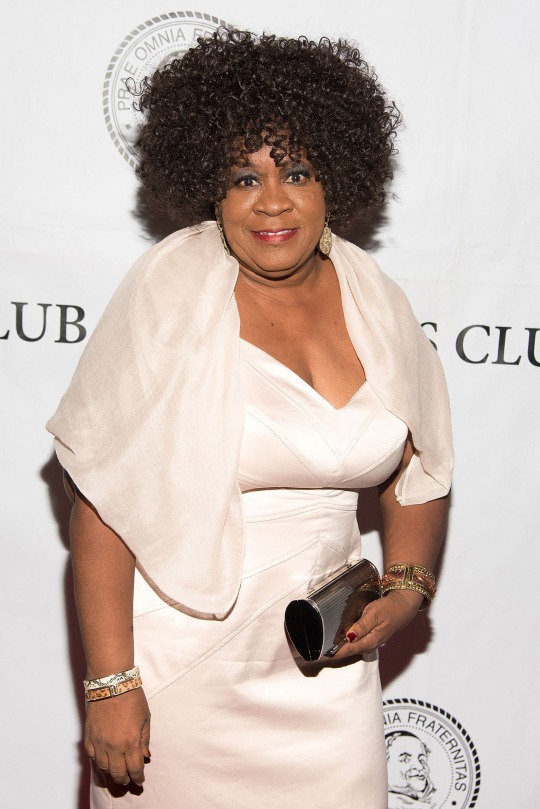
Bobby Humphrey is a flutist and singer. Her works have been sampled by the like of Digable Planets, Eric B & Rakim, Ludacris.

Megan Thee Stallion is a rapper, performer, dancer, actress. In simultaneity with her artistic craft as a Black female performer, she is an entrepreneur and has an educational background in health administration.

Missy Elliott is a songwriter, a producer, a rapper, a worldmaker, a performer, and a constant innovator.
The visual archives above best visually describe the poem. Here are some excerpts to whet your appetite:
We nod and nod and nod and nod; a sign of reluctance and wistfulness.
We're a leg lifted across a graceful back, a waste of shoulder: more oil in the voice.
and
Cars pace up the streets slurry with neutered teeth, a familiar grit, nobody smiling.
In every room there can be, an attempt at proper dislocation, sleepless beer.
and
Is she middle of the night curling, a head tense with needle marks, pointing ?
We resemble the carpeted grass of molten glass, the cake cracklings.
17 notes
·
View notes
Photo

Jazz saxophonist and flutist Eric Dolphy
144 notes
·
View notes
Text
LÉGENDES DU JAZZ
FREDDIE HUBBARD, UN GÉNIE MÉCONNU
‘’From the moment he played one note, you knew that was Freddie Hubbard. So he had a sound that was distinctive as Miles Davis, as Louis Armstrong, as Clifford Brown. I mean, he’s one of those trumpet players. He’s also an extraordinary powerful player - great stamina, great range. He swung very hard, was a beautiful ballad player {...}. He was quite a musician.’’
- Stanley Crouch
Né le 7 avril 1938 à Indianapolis en Indiana, Freddie Hubbard a commencé sa carrière musicale comme membre du groupe du Arsenal Technical High School à Indianapolis, où il a appris à jouer du tuba, du cor français et du mellaphone (une sorte de trompette), avant de fixer son choix sur la trompette et le flugelhorn. Freddie avait été initié au jazz par son frère Earmon Jr., un pianiste qui était un grand admirateur de Bud Powell.
Après avoir constaté son grand talent, le trompettiste Lee Katzman, qui avait joué dans l’orchestre de Stan Kenton, lui avait conseillé d’aller étudier au Arthur Jordan Conservatory of Music (devenu de nos jours le Jordan College of the Arts de l’Université Butler) avec Max Woodbury, le trompettiste principal de l’Indianapolis Symphony Orchestra. À l’adolescence, Hubbard avait participé à sa première session d’enregistrement en accompagnant les frères Wes et Montgomery. Il avait aussi collaboré avec le bassiste Larry Ridley et le saxophoniste James Spaulding. À la même époque où Hubbard participait à son premier enregistrement avec les frères Montgomery, il avait fondé un premier groupe nommé ‘’The Jazz Contemporaries’’ avec le bassiste Larry Ridley, le saxophoniste et flutiste James Spaulding, le pianiste Walt Miller et le batteur Paul Parker. Le groupe se produisait souvent au George’s Bar, un club très populaire sur l’Indiana Avenue.
UNE ASCENSION RAPIDE
En 1958, à l’âge de vingt ans, Hubbard s’était installé à New York. Hubbard avait connu un succès instantané en accompagnant les meilleurs musiciens de jazz de l’époque, dont Philly Joe Jones, Sonny Rollins, Slide Hampton, Eric Dolphy, J.J. Johnson et Quincy Jones. À la même période, Hubbard avait aussi partagé un appartement avec le multi-insrumentiste Eric Dolphy.
Sur la recommandation de Miles Davis, Hubbard avait signé un contrat avec Blue Note avec qui il avait enregistré son premier album comme leader en novembre 1960, intitulé ‘’Open Sesame.’’ Participaient à l’enregistrement le saxophoniste Tina Brooks, le pianiste McCoy Tyner, le bassiste Sam Jones et le batteur Clifford Jarvis. Six jours plus tard, Hubbard avait renvoyé l’ascenseur à Brooks en collaborant à son album True Blue. En l’espace d’un an, Hubbard avait enregistré deux autres albums, ‘’Going Up’’, avec McCoy Tyner et Hank Mobley, ainsi que ‘’Hub Cap’’, avec Julian Priester et Jimmy Heath.
Après avoir entendu Hubbard jouer avec le trompettiste Don Cherry, le saxophoniste Ornette Coleman l’avait invité à participer à son album ‘’Free Jazz.’’ En 1960-1961, Hubbard s’était également joint à Quincy Jones dans le cadre d’une tournée en Europe. Il avait aussi travaillé avec le batteur Max Roach.
En mai 1961, Hubbard avait collaboré avec John Coltrane sur son dernier enregistrement pour Atlantic, intitulé ‘’Olé Coltrane’’. Avec Eric Dolphy et Art Davis, Hubbard avait aussi été invité à participer au premier album de Coltrane pour Impulse, intitulé ‘’Africa-Brass.’’ En août 1961, Hubbard avait enregistré ‘’Ready for Freddy’’, sa première collaboration avec le saxophoniste Wayne Shorter, qui est considéré comme un des sommets de sa carrière. À la fin de la même année, Hubbard était devenu un partenaire régulier de Shorter lorsqu’il avait remplacé Lee Morgan avec les Jazz Messengers d’Art Blakey. Hubbard avait enregistré plus de dix albums live et en studio avec Blakey durant la période la plus productive du groupe. Les années 1960 avaient aussi été une période faste pour Hubbard, qui avait enregistré huit albums comme leader pour Blue Note, et plus d’une vingtaine comme membre d’autres formations. Hubbard était demeuré avec Blakey jusqu’en 1966, alors qu’il avait décidé de former l’un des nombreux petits groupes sous son nom. Faisaient également partie de la formation son ancien associé de Blue Note, James Spaulding, le pianiste Kenny Barron et le batteur Louis Hayes. Le groupe avait enregistré avec Atlantic.
C’est à cette époque que Hubbard avait commencé à se libérer des influences de Clifford Brown et de Lee Morgan et à développer son propre son. Il avait aussi remporté le prix du meilleur trompettiste de jazz décerné par le magazine DownBeat.
Pendant les années 1960, Hubbard avait aussi participé comme accompagnateur aux plus importants albums de l’époque, dont ‘’The Blues and Abstract Truth’’ d’Oliver Nelson, ‘’Out of Lunch!’’ d’Eric Dolphy, ‘’Maiden Voyage’’ d’Herbie Hancock, et ‘’Speak No Evil’’ de Wayne Shorter. Même s’il n’avait pas ouvertement adopté le free jazz, Hubbard avait participé à deux de ses albums-phares : ‘’Free Jazz’’ d’Ornette Coleman et ‘’Ascension’’ de John Coltrane, en plus de collaborer à l’enregistrement d’une des compositions les plus avant-gardistes de Sonny Rollins, intitulée ‘’East Broadway Run Down’’ (tirée de l’album du même nom), avec Elvin Jones et Jimmy Garrison, deux membres du célèbre quartet de John Coltrane.
‘’I don’t know how I met all these people’’, avait plus tard expliqué Hubbard. ‘’But a lot of them came to get me, too. They sought me out because they saw I wanted to experiment, and during that period, I was changing my style of the trumpet. I was trying to play the trumpet like a saxophone.’’
Le style de Hubbard avait changé après qu’il se soit établi à Hollywood dans les années 1970. En Californie, les trompettistes jouaient un rôle plus effacé et plus discret, et Hubbard avait dû s’adapter. Il racontait : ‘’You know, lifestyle out there is different from mine than in New York. I was in the Hollywood Hills, above the Bowl. I could look at the ocean on this side. I can hear the concerts free at the Bowl. And I had a big swimming pool. I had parties all the time, and the trumpet just was in the corner a lot of the time, when it should have been on my lips.’’
Hubbard avait connu son plus grand succès commercial dans les années 1970 lorsqu’il avait participé à une série d’albums pour la compagnie CTI Records de Creed Taylor, ce qui lui avait permis d’éclipser Stanley Turrentine, Hubert Laws et même George Benson. Même si ses premiers disques des années 1970, ‘’Red Clay’’, ‘’First Light’’ (qui avait remporté un prix Grammy en 1972 comme meilleure performance instrumentale par un artiste de jazz) et ‘’Sky Dive’’ avaient été plutôt bien reçus et étaient considérés comme ses meilleurs, les albums que Hubbard avait enregistrés plus tard (il avait même flirté avec le jazz-fusion en collaborant avec Red Clay dans le cadre de l’enregistrement des albums ‘’Straight Life’’, ‘’Sky Dive’’ et ‘’First Light’’) avaient été critiqués en raison de leur approche trop commerciale. L’album ‘’First Light’’ mettait en vedette les pianistes Herbie Hancock et Richard Wyands, les guitaristes Eric Gale et George Benson, le contrebassiste Ron Carter, le batteur Jack DeJohnette et le percussionniste Airto Moreira. En 1994, Hubbard avait renoué avec la chanteuse et compositrice Catherine Whitney, qui avait également collaboré à l’album ‘’First Light.’’
Après avoir signé avec Columbia, en 1977, Hubbard s’était joint au groupe tout-étoile V.S.O.P., aux côtés d’Herbie Hancock, de Tony Williams, de Ron Carter et de Wayne Shorter. Tous les membres du groupe à l’exception d’Hubbard avaient fait partie du quintet de Miles Davis au milieu des années 1960. Plusieurs des enregistrements en concert du groupe avaient été publiés plus tard. En 1978, Hubbard avait également collaboré à la pièce ‘’Zanzibar’’ du chanteur Billy Joel. La pièce était tirée de l’album ‘’52nd Street’’ qui avait remporté un prix Grammy l’année suivante comme meilleur disque de jazz.
PROBLÈMES DE SANTÉ ET DÉCÈS
Dans les années 1980, Hubbard avait fondé un nouveau groupe, cette fois avec Billy Childs et Larry Klein. Accueilli chaleureusement par la critique, le groupe avait présenté plusieurs concerts aux États-Unis et en Europe, souvent en compagnie du saxophoniste ténor Joe Henderson, avec un répertoire composé de pièces de hard bop et de jazz modal. Hubbard s’était également produit au festival de jazz de Monterey en 1980 et en 1989 (cette fois avec le vibraphoniste Bobby Hutcherson). Avec Woody Shaw, Hubbard avait enregistré deux albums pour Blue Note. Les deux hommes ont aussi joué en concert en duo de 1985 à 1987. Toujours en 1987, Hubbard avait co-dirigé l’enregistrement de l’album ‘’Stardust’’ avec Buddy Golson. L’année suivante, Hubbard avait de nouveau équipe fait avec Art Blakey à l’occasion d’un concert en Hollande, ce qui avait donné lieu à l’enregistrement de l’album ‘’Free the Wind.’’ La même année, Hubbard avait joué des solos de flugelhorn et de trompette sur deux pièces de l’album ‘’Reg Strikes Back’’ d’Elton John. En 1990, Hubbard avait fait une apparition au Japon dans le cadre d’un concert mettant en vedette le batteur Elvin Jones, le saxophoniste Sonny Fortune, les pianistes George Duke et Benny Green, les contrebassistes Ron Carter et Rufus Reid, et la chanteuse Salena Jones. Hubbard a également joué au festival de jazz de Varsovie, dans le cadre d’une performance qui avait été immortalisée sur l’album ‘’Live at the the Warsaw Jazz Festival’’, publié en 1992 par les disques Jazzmen.
Au début des années 1990, Hubbard, qui était déterminé à recommencer à jouer ce qu’il qualifiait de ‘’vrai jazz’’, s’était installé à Philadelphie et avait contribué à l’émergence de nouveaux talents en intégrant à sa nouvelle formation le contrebassiste Christian McBride, le saxophoniste Javon Jackson, le batteur Carl Allen et le pianiste Benny Green. Hubbard a également collaboré avec le New Jazz Composers Octet, avec lequel il avait joué et enregistré un album collectif dirigé par le trompettiste David Weiss.
En dépit de plusieurs problèmes de santé dont une blessure à la lèvre supérieure qui avait dégénéré en infection en 1992, Hubbard avait continué de jouer et d’enregistrer à l’occasion, même s’il n’était plus au sommet de son art comme il l’avait été au début de sa carrière. Découragé, Hubbard s’était mia à boire et avait contracté un ulcère qui avait failli causer sa mort. Hubbard expliquait: ‘’I started drinking Jack Daniel’s to feel good, you know ? Jack Daniel’s and Coca Cola. And I had an ulcer. I went over in London and I fell out. I’ve never passed out, but I lost four pints of blood. And the doctor said, ‘You’re going o clean up your body, because otherwise you’re looking to go.’ So I said, ‘Well, I’m not ready to go, so let me cool out.’’’
Refusant de se laisser abattre, Hubbard avait contribué à garder vivant le flambeau du jazz en contribuant à des cliniques et à des résidences dans de nombreux collèges américains.
Incarnation vivante du hard bop, Hubbard avait remporté plusieurs honneurs au cours de sa carrière. En 2006, la National Endowmnent for the Arts lui avait accordé la plus importante distinction remise à un musicien de jazz aux États-Unis, le NEA Jazz Masters Award. Au début des années 1970, il avait même supplanté Miles Davis dans les sondages organisés afin de désigner le meilleur trompettiste du monde du jazz.
Freddie Hubbard est mort le 29 décembre 2008 à Sherman Oaks, en Californie, à la suite de complications dues à une attaque cardiaque survenue le 26 novembre précédent. Il était âgé de soixante-dix ans. Peu avant son décès, Hubbard avait enregistré un dernier album intitulé ‘’On the Real Side.’’
À la fin de sa vie, Hubbard avait développé des liens étroits avec la Jazz Foundation of America. Hubbard expliquait: ‘’When I had congestive heart failure and couldn't work, The Jazz Foundation paid my mortgage for several months and saved my home! Thank God for those people." À la fin de sa vie, la Fondation avait d’ailleurs assuré les soins de Hubbard par l’entremise de son fonds d’urgence. Après sa mort, les héritiers du trompettiste avaient demandé que des dons admissibles pour fins d’impôt soient faits en son nom à la Jazz Foundation of America.
Considéré comme un des trompettistes les plus importants et les plus innovateurs du bop, du hard bop et du post-bop, Freddie Hubbard s’était progressivement affranchi de l’influence de géants comme Miles Davis et Clifford Brown qui avaient été ses modèles au début de sa carrière pour forger sa propre personnalité musicale. Au cours de sa longue carrière, Hubbard a enregistré plus de cinquante albums sous son nom en plus de collaborer avec les plus importants artistes de jazz de son époque. Peu après sa mort en 2008, le magazine Down Beat avait qualifié Hubbard de ‘’trompettiste le plus puissant et prolifique’’ de l’histoire du jazz (il avait enregistré plus de 300 albums en tout et pour tout, tant comme leader que comme collaborateur). Le critique de jazz Stanley Crouch le considérait comme le trompettiste le plus important et le plus original des quarante dernières années. Crouch précisait: ‘’From the moment he played one note, you knew that was Freddie Hubbard. So he had a sound that was distinctive as Miles Davis, as Louis Armstrong, as Clifford Brown. I mean, he’s one of those trumpet players. He’s also an extraordinary powerful player - great stamina, great range. He swung very hard, was a beautiful ballad player and seemed to have very few limitations in terms of getting through material, whether the material was very simple material or very complex material. He was quite a musician.’’
Le trompettiste Wynton Marsalis considérait Hubbard comme une des principales influences. Il expliquait: ‘’All the trumpet players in the ‘70’s, you can hear Freddie Hubbard’s sound and everything worth playing. He’s such a phenomenal trumpet player - just the largeness of his sound, the velocity and the swing.’’
©-2023-2024, tous droits réservés, Les Productions de l’Imaginaire historique
SOURCES :
‘’Freddie Hubbard.’’ Wikipedia, 2022.
‘’Freddie Hubbard, Trumpeter born.’’ National Endowment for the Arts, 2022.
VITALE, Tom. ‘’Freddie Hubbard : A Jazz Icon Remembered.’’ All Things Considered, 11 août 2001,
3 notes
·
View notes
Text



寫給我。 寫作好比接吻,用心靈親吻,只不過少了唇。
Mi scriva. Scrivere è come baciare, solo senza labbra. Scrivere è baciare con la mente. 💋
─ Daniel Glattauer 丹尼爾.葛拉陶 b.1960 奥地利作家和前記者(台灣也有他的中譯書) He is an Austrian writer and former journalist. His literary works were translated into 40 languages, sold over 3 million times and adapted for radio, theater, television and cinema alike, even beyond the German speaking countries. In 2006 he was nominated for the German Book Prize (Deutscher Buchpreis) for his novel Love Virtually.
🎧 Jazz/Soul💐 [1976] Kathryn Moses – Kathryn Moses [Full Album] ( She's a Jazz flutist, Saxophonist, composer… musician. I love her music. xoxo Lan~*)
00:00 01 - I Met A Special Man
02:06 02 - Oleo
06:34 03 - My Romance
12:13 04 - Midnight
20:45 05 - Ready Or Not
24:25 06 - Touch Me
31:53 07 - Prince Charming's Brother
35:54 08 - Midmorning
youtube
about photos :
● Huang Shan - China (Photographed by Emmanuel Boitier)
中國, 黃山 👍世人美譽: 「天下第一奇山」。The area is well known for its scenery, sunsets, peculiarly-shaped granite peaks, Huangshan pine trees, hot springs, winter snow and views of the clouds from above. Huangshan is a frequent subject of traditional Chinese paintings and literature, as well as modern photography. It is a UNESCO World Heritage Site and one of China’s major tourist destinations.
● 我喜歡帶了垢的心和不安的意念。
那些經歷過艱辛生活的老靈魂;
那些散發出最美光芒的人。
I like dirty hearts and restless mind.
The old souls that have known hard lives;
the ones who cast the most beautiful shine.
─ Nicole Lyons/ Writer, Poet
● 很愛這時尚個性的銀髮,優雅又有魅力,捕捉我的眼! Lan~*
Trendy Grey
Collection Automne-Hiver 2015/16
and
Model - Alessandro Manfredini
#daniel glattauer#kathryn moses#huang shan - china#中國-黃山#天下第一奇山#emmanuel boitier#alessandro manfredini#trendy grey#Youtube
22 notes
·
View notes
Text
Frank Wess: Harmonizing Jazz, Weaving Legacy
Introduction:
In the intricate realm of jazz, Frank Wellington Wess emerged not only as a virtuoso saxophonist and flutist but also as a key architect of the genre’s evolution. From his early days in Kansas City to his influential tenure with Count Basie and beyond, Wess left an indelible mark on jazz. This article explores the life, career, and enduring legacy of this luminary figure.
Early…

View On WordPress
#Benny Carter#Billy Eckstine#Clark Terry#Count Basie#Count Basie Orchestra#Flutes & Reeds#Frank Wess#Hank and Frank II#Jazz Flutists#Jazz History#Jazz Saxophonists#Kenny Barron#Lester Young#New York Jazz Quartet#The Jazz Composer&039;s Orchestra
1 note
·
View note
Text
TWST OC Profile ~ Cary Holger
"I am doing my very best to be part of your world." ~ Cary


Template by @/piraticusdorm
Merman form art below ⬇️
Personal Info
Name: Cary Holger
Nickname: Little Starfish
Gender: Male
Age: 19
Species: Blue Green Chromis Merman
Birthday: 10/5
Zodiac: Libra
Height: 199cm/6ft'5in"
Orientation: Pansexual
Eye Color: Umber
Hair Color: Scarlet
Homeland: Kingdom of Shellticthalassa
Family: King of Shellticthalassa - Father
5 older brothers
Older sister
Twist of Ariel from Disney's The Little Mermaid,mashup of musical & live action versions
School Info
School: Royal Sword Academy
School Year: 3rd
Occupation: Prince,Vocalist,Item Collector
Best Subject: Music,Biology(Sea)
Other Info
Dominant Hand: Left
Favorite Food: Seaweed Cookies
Least Favorite Food: Seafood(Fish)
Dislikes: Strictness,Seafood,Being Upstaged,Silence for too Long,Confusing Surface Logic,Unfulfilled Dreams,
Likes: Music,Learning New Things,Forks,Collecting Random Things,Dancing,Hair Care,Musicals,R&B,Jazz,Pop
Talents: Singing,Swimming,Oceanography,Marine Biology,Flutist,Getting Lost,Asking Questions
Unique Magic: Spiral Song - While in water with focus can stir up a small to large water cyclone around him that persists longer if Cary sings to it. It protects him from most harm like sharks,etc.
Personality: Cary has a very sweet and carefree personality. Most will say he is just a pleasure to be around but needs some guidance as sometimes clueless to some modern surface logic. He can get kinda sassy when it comes to singing and often doesn't get along with other singers except his siblings and other merfolk musical people.
Fun Facts: Cary is the youngest child of the royal merfamily of Shellticthalassa,a small sea kingdom in the Coral Sea known for Musical performances.
He transferred to RSA from an undersea school. Convinced his father to allow this by showing him all the musical wonders he was missing and his father gave in cause Cary is his baby boy.
Cary has a big collection of random stuff most on the surface would call junk but he sees them as so interesting. His favorite is metal utensils and has found them useful as hair tools.
Can't help but return to the sea when he can to visit fish friends and family. Has gotten the hang of his legs but may stumble from time to time.

Is so friendly and always looking to make surface friends and even new sea ones now that he can meet so many more.
Loves to serenade someone if he is seeking their attention. May come off as flirty but he doesn't mean that way usually just hopes his voice makes others happy.
Sings in a group with siblings for years but now that he on his own mostly wants to go solo and try to make it big on the surface so he can probably stay longer.
Needs a paper map of rsa or often a staff member goes to find him as he gets lost very easily. He has ended up at NRC on accident twice.
Is quick to get sassy and jealous of other singers with established careers on the surface cause feels like they are judging him because he is not human. Sometimes wishes he fully was so didn't feel this way.
Art credit
Pose Refs: Utapri Live Renji - UK Street Snaps,Shining TV Style cards
Assets: TWST RSA Student assets used
#twisted wonderland#twst oc#twisted wonderland oc#royal sword academy#rsa oc#prince oc#cary#Cary Holger#twst ariel#the little mermaid
20 notes
·
View notes
Text
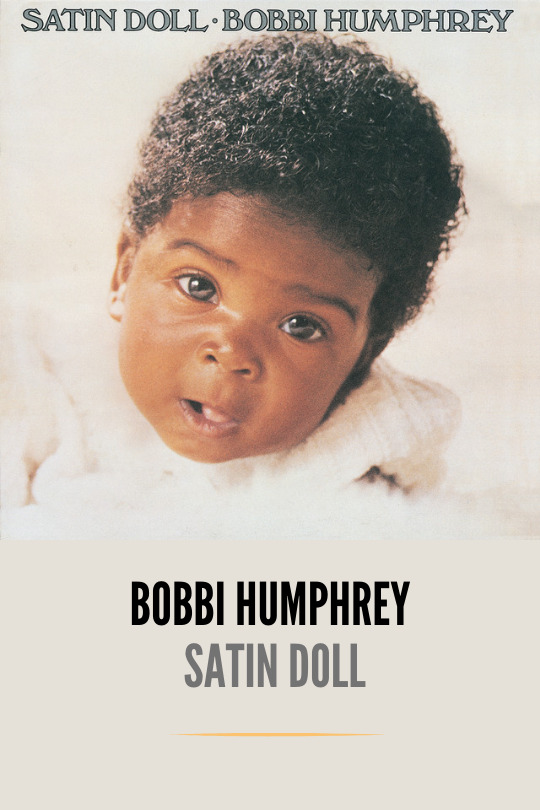
Bobbi Humphrey – Satin Doll
Satin Doll is the fourth studio album by American jazz flutist Bobbi Humphrey recorded in 1974 and released on the Blue Note label.
2 notes
·
View notes
Text
Baikida E.J. Carroll - Orange Fish Tears - Souffle Continu Records reissue of 1974 LP
In 1972, trumpeter Baikida Carroll and some of his colleagues from the Black Artists Group (more precisely saxophonist/flutist Oliver Lake, trombonist Joseph Bowie, drummer Charles "Bobo" Shaw and trumpeter Floyd LeFlore) took the advice of their friends in the Art Ensemble Of Chicago and left their native Missouri to come and discover the bright lights of Paris for themselves. The following year they would even get the chance to record their only album which would rapidly attain mythical status and a collector’s item: “In Paris, Aries 1973”.
Therefore, it was not surprising that they crossed paths with Jef Gilson in the capital. He was always on the lookout for new artists for his recently formed Palm label and had been active on many fronts in jazz since the end of the 50s. The French bandleader/pianist/composer/sound engineer had already recorded, in the preceding months other American musicians who would go on to have great careers: Byard Lancaster, Keno Speller, Clint Jackson III, Khan Jamal… Gilson therefore offered Baikida Carroll the chance to record his first album under his own name, which would be the 13th release on the label. Carroll logically asked Oliver Lake to join him. He also recruited Manuel Villaroel, a young Franco-Chilien pianist from the group Matchi-Oul, who had already released an album on Futura in 1971 and would release another on Palm in 1976. The group was completed with the addition of Brazilian percussionist Naná Vasconcelos, who had just released a well-received album on the Saravah label. They were ready to enter the studio for the 3rd, 4th and 5th June 1974.
With these two sides, and in under 45m, Baikida Carroll and his musicians show just what they can do, from cerebral to charnel without ever simplifying things. This is an indispensable album if you are a fan of free-wheeling avant-garde music from the Art Ensemble of Chicago to Sonic Youth and including Shabaka Hutchings and Rob Mazurek. For those with good taste, in other words.
#Bandcamp#Baikida E.J. Carroll#jazz#spiritual jazz#1974#reissue#palm records#Souffle Continu Records
6 notes
·
View notes
Text
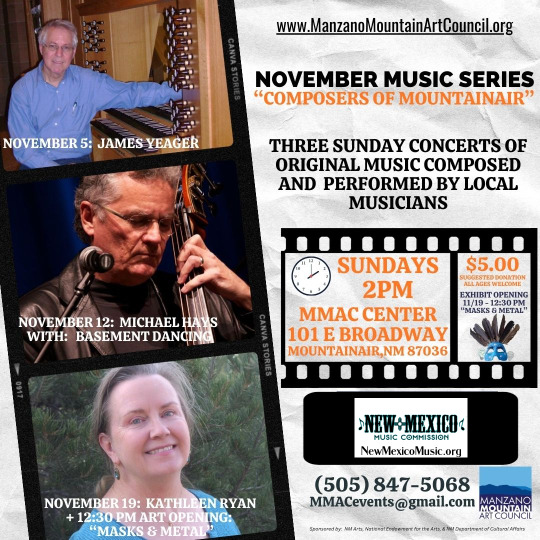
Sundays at 2pm at MMAC Center
Three Sunday concerts of original music composed and performed by local musicians
Events made possible by funding from the New Mexico Music Commission
https://www.newmexicomusic.org/
November 5: James Yeager
James Albert Yeager moved to New Mexico in 2009. He has performed regularly as conductor, organist, harpsichordist, and choral accompanist. He retired as Professor of Sacred Music at the Josephinum College in Columbus, Ohio (1984-2009). James has done numerous compositions and arrangements, including music for two short films. His orchestral works have been performed in Albuquerque and Santa Fe. At present, his primary musical interest remains as a composer
Program: The program will center on James’ three recent compositions: Passacaglia for Organ & Orchestra (2022), Fugue for Piano and Chamber Orchestra ”Mystical Desert”(2023), and Sonata for Piano Quintet (2023). Since the Passacaglia and the Fugue require large ensembles, they will be performed using recordings from Ravel Virtual Studios (NYC) . The Sonata will be played by New Mexico musicians - Flutist Ms. Hyorim Kim, a string quartet of Eric Sewell, Grant Hanner and Lisa Donald, and pianist Natalia Tikhovidova. - as a premiere performance. James will also play short pieces from his film scores. The program will last one hour and is free to the public.
November 12: Michael Hays
Mike Hays is a retired English teacher who has been playing music, especially on bass, since he was a young teen. In the last ten years, he has taken his interest in songwriting more seriously and has been creating jazz-based both vocal and instrumental compositions for the group he is working with. The current group (to whom Mike is deeply grateful) is more classically based, and the audience of the November Concert Series will notice his current compositions reflect this.
Program: Basement Dancing is a group that performs music written by Michael Hays. The group comprises Luis Delgado on clarinet and flute, Juli Palidino on viola and violin, Katie Harlow on cello, mandolin and accordion, Joseph Sabella on drums, and Michael Hays on bass and vocals. . Vocal songs at this concert will include musical portraits of the lonely soul waiting for his lost love in the Plaza de los Arboles Muertos, of the longing that hapless Señor Sapo feels as he watches a lovely circus acrobat, and of the nocturnal activities of Groany Bones, a skeleton who leads a danse macabre.
November 17: Kathleen Ryan + Exhibit Opening of "Masks & Metal"
Composer/pianist Kathleen Ryan is a Whisperings Solo Piano artist. She was the Professional Music Teachers of New Mexico commissioned composer in 2008, for which she composed a set of 24 piano left-hand-alone preludes titled Verbs. Several of her piano solo pieces were featured in the Emmy Award-winning Iowa Public TV special, The Seasons. Ryan lives near Mountainair with her husband and two quirky but inspiring cats.
Program: Composer/pianist Kathleen Ryan's piano solo performance will illustrate aspects of her composer’s life: being inspired, becoming ambitious, recovering from writer’s block, making money, and recycling teenage angst songs into piano solos. She will finish with some premieres, including music that’s not quite composed just yet! The full range of her 21st century impressionist style will be heard, from silly to soothing, from complex to simply serene.
#mmac#visitmountainair#art#music#live music#NovemberMusicSeries#JamesYeager#MichaelHays#BasementDancing#KathleenRyan#ArtOpening#MasksAndMetal
3 notes
·
View notes